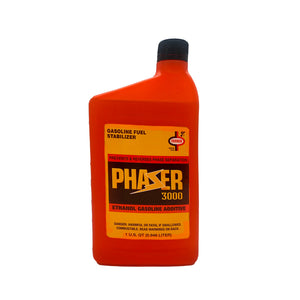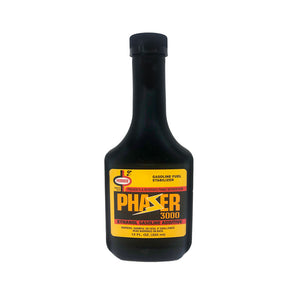Your Cart is Empty
Free Freight at 650 Lbs+


For a maintenance blend, we recommend you use a treatment ratio of approximately 1:500 to 1:1000 gallons of Phaser 3000 to fuel ratio. Consider using the 1:500 ratio in marine markets, or if you operate any vehicle in a predominately humid or wet environment.
If phase separation has already happened, a much higher dosage is required to reverse separation. A 1:30 separation reversal dosage is for 10% ethanol containing gasoline that has been contaminated with ½% water. Consider starting with a 1:100 phaser 3000 to fuel ratio and see if the fuel mixture reverts to a homogeneous state. Please keep in mind that the barometric pressure, the temperature, and the percentage of H2O present in the fuel can adjust the ratio required in reverting to a homogeneous state.
Phaser 3000 is engineered for use in gasoline engines to improve performance, clean, remove the negative effects associated with engine acids, remove carbon, sludge, gum, or varnish from fuel injectors, carburetors, valves, cylinders, or pistons.
When an ethanol blended gasoline is saturated because of contact with H2O, layers are created. The upper layer is comprised of a decreased octane rating while the bottom layer is unlikely to ignite during the normal combustion cycle of the engine. If this two-layer state is reached, "phase separation" occurs and the engines performance deteriorates accordingly.
Phaser 3000, applied due to impending phase separation, or previously occurred phase separation, will return the layers to a single homogeneous mixture by absorbing H2O molecules. This breaks the hydrogen bonds formed and encapsulating H2O molecules completely by the Phaser 3000 product.
This product is recommended for operation in gasoline engines, in particular ethanol blended gasoline to prevent the specific corrosive results of engine acids made during the combustion cycle. This includes internal combustion engines in salt or fresh water environments in the marine market. It can be used to absorb moisture, prevent icing or stalling, remove gum, carbon, or sludge. It can improve combustion, clean fuel injectors, carburetors, free sticky valves, improve combustion performance, and finally reduce maintenance costs and associated downtime.
Fuel enters the tank in some obvious and not-so-obvious ways. Obviously rain water with an open tank cap can allow water into the tank. However, the more likely explanation for water entering the tank revolves around the highly hygroscopic nature of ethanol: normal condensation of water in the air can bring water into a tank. As the ambient temperature decreases, the easier it is for this process to occur and water to enter into the fuel tank.
For the average amount of water in a fuel tank, not caused by gross negligence or intentional vandalism, say 1/2%, water can lead to knocking or physical damage to pistons or valves. These are the typical results in a four-stroke engine.
In a two-stroke, Primrose Phaser 3000, will keep oil in suspension, disperse water, and keep all warranties compliant. It stabilizes gasoline in storage for two years prior to phase separation.
Fuel stored in storage tanks, if not used quickly, will create this phase separation that can damage engines and lead to reduced octane rating. Consider using Phaser 3000 Fuel Stabilizer when storing fuel. A 1:1000 gallon ratio of Phaser 3000 to fuel is ideal for this purpose.